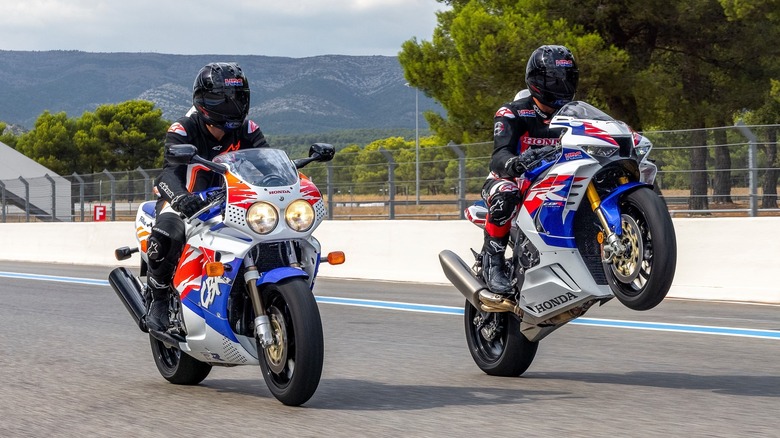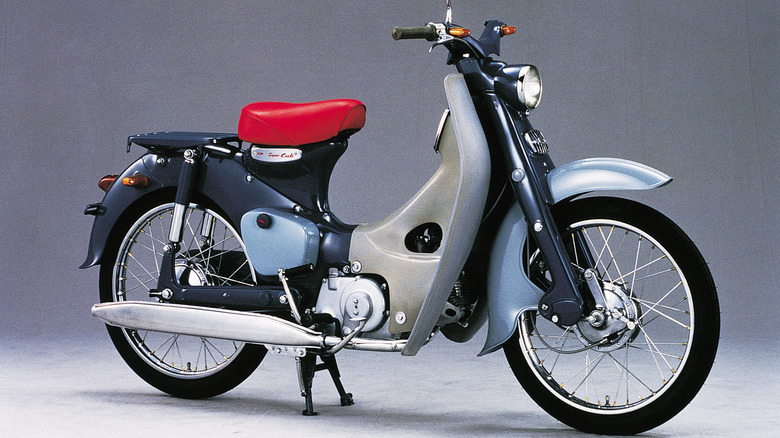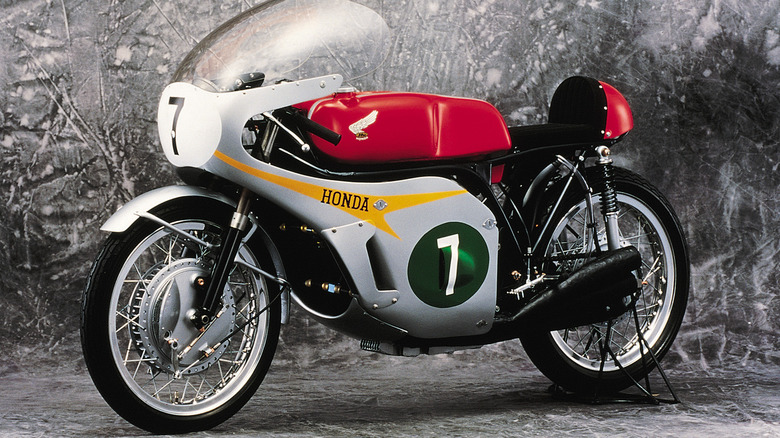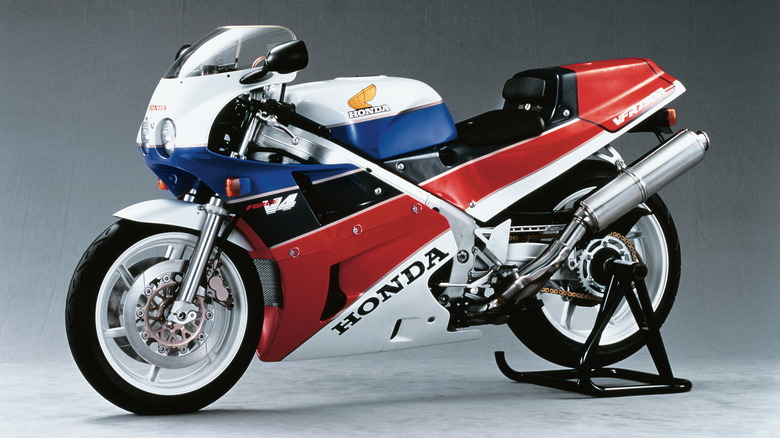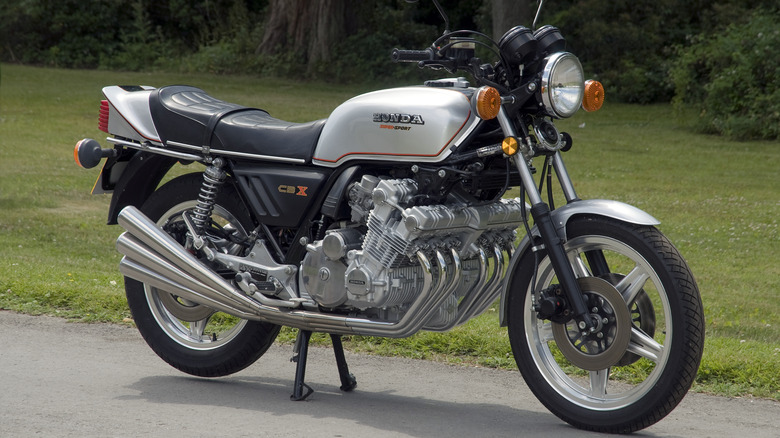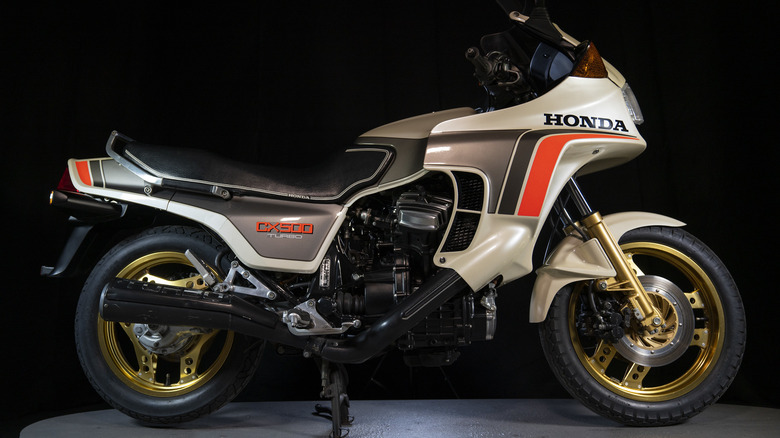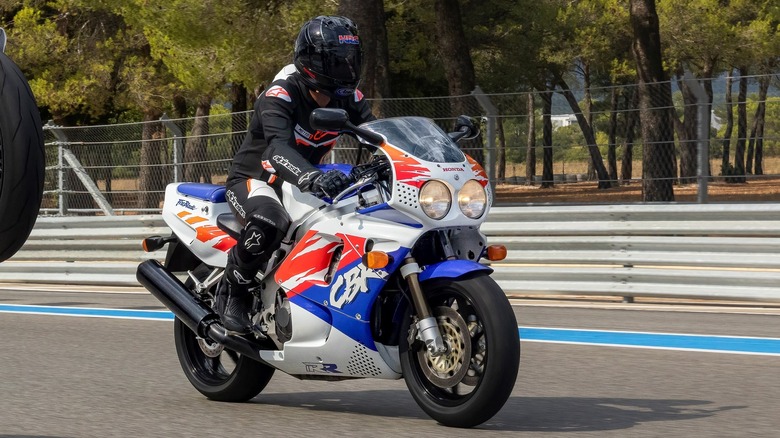6 Of The Coolest Looking Honda Motorcycles Ever Made
Whether it's race-bred high-performance machines, long-distance cruisers, homologation motorcycles, tiny eco-friendly scooters, or customizable cafe bikes, Honda has made some of the coolest machines on two wheels.
Granted, what's "cool" is entirely subjective, especially when it comes to motorcycles. For some riders, functional design is valued above all else by optimizing performance, and anything visually pleasing is just a happy byproduct. Others want a bit of flash on purpose, lusting after something that matches their personality or riding style with overall performance playing second fiddle. Luckily for both of these kinds of riders and everyone in between, Honda's got you covered.
Like any manufacturer with such a long manufacturing history, there are some stinkers (special shout out to bikes like the utterly strange DN-01), but those are a bit less common. Overall, Honda has an excellent lineup of cool-looking motorcycles offering both style and performance. They've also got a rich racing history, which includes several ground-breaking motorcycles that ooze cool.
Honda Super Cub
The Honda Super Cub is an excellent example of sticking to a successful, functional design. First released in 1958, the Super Cub had mid-century modern styling that perfectly fit the era. The current Honda Super Cub C125 is widely similar. It has simple, retro styling that harkens back to the scooter's roots with similar color schemes, bodywork that makes it easy to get on and off, tall wheels, and skinny tires.
The original Super Cub was designed when less than 10% of Japan's roads were paved, so it had to be rugged, but it also had to be easy to use to appeal to the masses. The skinny tires and tall wheels meant it could handle well on the rough roads in Japan. The hand controls were easy to operate, and shifting gears was done with your feet — designed so that soba delivery riders could get by just using one hand to ride.
These designs gave the Super Cub a simple, clutter-free look — a look that is still part of its design language and approachability today. As a result, it is one of the most popular vehicles of all time and one of the best Honda motorcycles ever made; Honda has sold over 100 million Super Cubs since its debut in the '50s.
Honda RC166 250
The Honda RC166 is a masterpiece of design and engineering. Sleek, sophisticated, and built without compromise, the RC166 was introduced for the 1966 World Motorcycle Grand Prix season, and it went on to win all five classes of the series that year (a first for any manufacturer). Then, in 1967, the RC166 won the championship again. Honda felt satisfied with that result, so instead of sticking around, they pulled out of GP altogether and turned their focus to the paddock at Formula 1.
What they left us with, though, is a bike with near-perfect proportions, curved body lines that sweep back with aerodynamic purpose, and an unforgettable soundtrack blasting from the six individual exhaust pipes.
The RC166 was powered by a six-cylinder engine with just 250cc of displacement, which contributed to its other-worldly sound. The engine revved to an astonishingly high 18,000 RPM, and the RC166 sounded like nothing else on two wheels. If you've never heard one before, take a few minutes and do a quick search for sound clips of the RC166 — you'll be happy you did.
Honda RC30
Sold as a homologation motorcycle, the RC30 was offered to the public in limited numbers so that Honda could go racing with it. It had iconic styling cues like the aluminum single-sided swingarm, round double headlights, and Honda's red, white, and blue color scheme. It is also one of the rarest Honda motorcycles out there. Only 316 bikes were imported to the United States in 1990.
Racebike influence was everywhere on this bike. The single-sided swingarm, for example, is an elegant bit of design, but it has a function, too: quicker rear wheel-and-tire changes on the track. The front fork sliders had a functional purpose taken from racing as well – they allowed the front brake calipers to stay put when changing out a front wheel.
Then there are the hand-cinch fasteners along the side of the bike that prioritized quick fairing changes but looked good as well (especially if you've got them all lined up and pointing the same way like any detail-oriented mechanic would).
Honda CBX 1000
Few motorcycles have a look as unique as the Honda CBX 1000. Released in 1987, the CBX 1000 was powered by a 1047cc inline-six cylinder engine that took center stage. Most motorcycles have four cylinders (or less), so there's not as much piping to show off, but the CBX 1000, with all six cylinders lined up perpendicular to the bike's layout, looks like a peacock with all its feathers on full display.
The six exhaust pipes exiting the front of the engine are boldly displayed, unobstructed by bodywork, and lined up neatly in a row. Then, instead of combining into an exhaust collector and combining into one exhaust pipe, all six pipes remain separated all the way to the tail of the bike.
The CBX 1000 has all the classic cafe bike styling cues you'd expect: a long, relatively flat seat, exposed suspension and drivetrain components, and a big circular single headlight. This design was partly inspired by the Honda GP bikes of the 1960s, like the aforementioned RC166, making it even cooler by association.
Honda CX500 Turbo and CX650 Turbo
Hidden under bodywork and behind heat exchangers, the turbocharger isn't easy to spot on the Honda CX500 Turbo or the CX650 Turbo, but you won't mistake these bikes for being naturally aspirated. "TURBO" is plastered on the exhaust pipes, stickered on the front fairing above the headlight, and written with a bit more subtlety on the sides of the gas tank.
Very few motorcycles throughout history have been turbocharged, and the CX500 was the first production motorcycle to get a turbocharger –so the bragging was acceptable for the era.
The design of the CX500 and CX650 had lots of typical '80s flare with bright colors and bright wheels. It's a vibe that would pair easily with mullets or high-top fades. The fonts used to spell out "TURBO" on the side of the bike are quintessentially '80s, too, with color combinations that are as bright and bold as a pair of neon-colored sunglasses. Rad.
[Image by Zweiradmuseum Neckarsulm via Wikimedia Commons | Cropped and scaled | CC BY-SA 4.0]
Honda CBR900RR Fireblade
An iconic name in performance, the CBR is one of history's best-performing motorcycles. There are dozens of CBR bikes from over the years, spanning all sorts of engine displacement and cylinder count. The earliest CBRs had no fairings, but most have been covered up in plastic over the years, looking widely similar, with small evolutions in style to keep up with the times. One of the most unique bikes to use the CBR name and the first one to get the "RR" suffix is the 1992 CBR1000RR Fireblade.
The CBR900RR Fireblade is the 1990s on two wheels. It combines the styling of a dixie cup, a bleached-blonde boyband, and a Miami Vice episode. The '92 Fireblade used a 900cc engine, but it was built on the dimensions of a smaller 750cc motorcycle, so it remained lightweight and compact.
That formula continued with several CBR bikes — lightweight and compact packages with shared dimensions. The CBR600RR and CBR1000RR, for instance, shared the same wheelbase and nearly identical bodywork for much of their existence.
